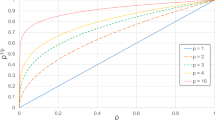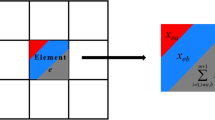Abstract
Considering both stress and stability factors in topology optimization is of great importance from both theoretical and practical perspectives. This work proposes an efficient stress-based structural stability approach to the topology optimization framework using multiple materials. Specifically, descriptions of the multimaterial structure’s layout defining interpolated material tensors are performed using the generalized solid isotropic material with the penalization (SIMP) method. To achieve this, a rule for determining the difference between solid and empty regions is used to keep the buckling constraint active while avoiding the appearance of pseudo modes. Also, an extendedly refined adaptive continuation method (RACM) is developed for the first time for multimaterial problems under stability constraints to determine the penalization parameter values so that the buckling constraints are appropriately considered throughout the optimization process. This automatic scheme for adjusting the penalization parameter is introduced to deal with the conflict between structural stiffness and stability requirements, thus achieving better designs. In addition, the von Mises stresses of the elements are aggregated using a P-norm function to measure the global stress level. The density filter is then utilized to suppress the checkerboard formation in each topological phase of the current approach’s material distribution. The method of moving asymptotes (MMA) is used as an optimizer to update density design variables in the optimization process. The mathematical expressions of the proposed method are delivered in detail. Several numerical examples are presented to illustrate the effectiveness of the proposed method. Overall, the proposed approach considers both stress and stability factors rigorously and systematically, and the results demonstrate its effectiveness in producing better designs in topology optimization problems involving multiple materials.

























Similar content being viewed by others
References
Bendsøe MP, Kikuchi N (1988) Generating optimal topologies in structural design using a homogenization method. Comput Methods Appl Mech Eng 71:197–224
Zhou M, Alexandersen J, Sigmund O, Pedersen CBW (2016) Industrial application of topology optimization for combined conductive and convective heat transfer problems. Struct Multidiscip Optim 54:1045–1060
Regazzoni F, Parolini N, Verani M (2018) Topology optimization of multiple anisotropic materials, with application to self-assembling diblock copolymers. Comput Methods Appl Mech Eng 338:562–596
Cui M, Luo C, Li G (2021) The parameterized level set method for structural topology optimization with shape sensitivity constraint factor. Eng Comput 37:855–872
Li W, Wang GG (2022) Elephant herding optimization using dynamic topology and biogeography-based optimization based on learning for numerical optimization. Eng Comput 38:1585–1613
Xia L, Huang X, Xie YM (2016) Bi-directional evolutionary structural optimization on advanced structures and materials: a comprehensive review. Arch Comput Methods Eng 25:437–478
Han YS, Xu B, Zhao L, Xie YM (2019) Topology optimization of continuum structures under hybrid additive-subtractive manufacturing constraints. Struct Multidiscip Optim 60:2571–2595
Gai Y, Zhu X, Zhang YJ (2020) Explicit isogeometric topology optimization based on moving morphable voids with closed B-spline boundary curves. Struct Multidiscip Optim 61:963–982
Olhoff N, Rasmussen SH (1977) On single and bimodal optimum buckling loads of clamped columns. Int J Solids Struct 13:605–614
Cox S, Overton M (1992) On the optimal design of columns against buckling. SIAM J Math Anal 23:287–325
Cox PG, Hu KK (1995) The shape of the ideal column reconsidered. Math Intell 15:62–67
Rozvany G (1996) Difficulties in topology optimization with stress, local buckling and system stability constraints. Struct Optim 11:213–217
Ohsaki M, Ikeda K (2007) Stability and optimization of structures: generalized sensitivity analysis. Mechanical Engineering Series. Springer, Berlin
Neves MM, Rodrigues H, Guedes JM (1995) Generalized topology design of structures with a buckling load criterion. Struct Optim 10:71–78
Min SJ, Kikuchi N (1997) Optimal reinforcement design of structures under the buckling load using the homogenization design method. Struct Eng Mech 105:565–76
Neves MM, Sigmund O, Bendsøe MP (2002) Topology optimization of periodic microstructures with a penalization of highly localized buckling modes. Int J Numer Method Eng 54:809–834
Rodrigues H, Guedes H, Bendsoe MP (2002) Hierarchical optimization of material and structure. Struct Multidiscip Optim 24:1–10
Coelho PG, Guedes PR, Guedes JM (2008) A hierarchical model for concurrent material and topology optimisation of three-dimensional structures. Struct Multidiscip Optim 35:107–115
Rahmatalla S, Swan C (2003) Continuum topology optimization of buckling-sensitive structures. AIAA J 41:1180–1189
Browne PA, Budd C, Gould NIM, Kim HA, Scott JA (2012) A fast method for binary programming using first-order derivatives, with application to topology optimization with buckling constraints. Int J Numer Methods Eng 41:1026–1043
Thomsen CR, Wang F, Sigmund O (2018) Buckling strength topology optimization of 2D periodic materials based on linearized bifurcation analysis. Comput Methods Appl Mech Eng 339:115–136
Ferrari F, Sigmund O (2019) Revisiting topology optimization with buckling constraints. Struct Multidiscip Optim 59:1401–1415
Ferrari F, Sigmund O, Guest JK (2021) Topology optimization with linearized buckling criteria in 250 lines of Matlab. Struct Multidiscip Optim 63:3045–3066
Nguyen MN, Hoang VN, Lee D (2022) Concurrent topology optimization of coated structure for non-homogeneous materials under buckling criteria. Eng Comput 38:5635–5656
Nguyen MN, Hoang VN, Lee D (2023) Multiscale topology optimization with stress, buckling and dynamic constraints using adaptive geometric components. Thin-Walled Struct 183:110405
Bendsoe MP, Sigmund O (2003) Topology optimization: theory, methods, and applications. Springer, New York
Doan QH, Lee D (2017) Optimum topology design of multimaterial structures with non-spurious buckling constraints. Adv Eng Softw 114:110–120
Doan QH, Lee D, Lee J (2019) Design of buckling constrained multiphase material structures using continuum topology optimization. Meccanica 54:1179–1201
Zhou M (2004) Topology optimization for shell structures with linear buckling responses. In: Proceedings of WCCM VI in conjunction with APCOM’04, Beijing, China, pp 795–800
Gao X, Ma H (2015) Topology optimization of continuum structures under buckling constraints. Comput Struct 157:142–152
Pian THH (1964) Derivation of element stiffness matrices by assumed stress distributions. AIAA J 2:1333–1336
Pian THH, Sumihara K (1984) Rational approach for assumed stress finite elements. Int J Numer Methods Eng 20:1685–1695
Gao X, Li L (2017) An adaptive continuation method for topology optimization of continuum structures considering buckling constraints. Int J Appl Mech 9:1750092
Duysinx P, Bendsøe MP (1998) Topology optimization of continuum structures with local stress constraints. Int J Numer Methods Eng 43:1453–1478
Kirsch U (1990) On singular topologies in optimum structural design. Struct Optim 2:133–142
Cheng G, Jiang Z (1992) Study on topology optimization with stress constraints. Eng Optim 20:129–148
Yang RJ, Chen CJ (1996) Stress-based topology optimization. Struct Optim 12:98–105
Luo Y, Wang M, Kang Z (2013) An enhanced aggregation method for topology optimization with local stress constraints. Comput Methods Appl Mech Eng 254:31–41
Kiyono CY, Vatanabe SL, Reddy JN (2016) A new multi-p-norm formulation approach for stress-based topology optimization design. Compos Struct 156:10–19
Cheng G, Guo X (1997) epsilon-relaxed approach in structural topology optimization. Struct Multidiscip Optim 13:258–266
Bruggi M (2008) On an alternative approach to stress constraints relaxation in topology optimization. Struct Multidiscip Optim 36:125–141
Bruggi M, Duysinx P (2012) Topology optimization for minimum weight with compliance and stress constraints. Struct Multidiscip Optim 46:369–384
Paris J, Navarrina F, Casteleiro M (2009) Topology optimization of continuum structures with local and global stress constraints. Struct Multidiscip Optim 39:419–437
Holmberg E, Torstenfelt B, Klarbring A (2013) Stress constrained topology optimization. Struct Multidiscip Optim 48:33–47
Nguyen HS, Kim HG (2020) Stress-constrained shape and topology optimization with the level set method using trimmed hexahedral meshes. Comput Methods Appl Mech Eng 366:113061
Nguyen HS, Nguyen TN, Nguyen TT (2022) A finite element level-set method for stress-based topology optimization of plate structures. Comput Math Appl 115:26–40
Le C, Norato J, Bruns T, Ha C, Tortorelli D (2010) Stress-based topology optimization for continua. Struct Multidiscip Optim 41:605–620
Banh TT, Lee D (2018) Multimaterial topology optimization design for continuum structures with crack patterns. Compos Struct 186:193–209
Banh TT, Luu GN, Lieu XQ, Lee JH, Kang J, Lee DK (2021) Multiple bi-directional FGMs topology optimization approach with a preconditioned conjugate gradient multigrid. Steel Compos Struct 41(3):385–402
Wang Y, Luo Z, Kang Z, Zhang N (2015) A multi-material level set-based topology and shape optimization method. Comput Methods Appl Mech Eng 283:1570–1586
Liu P, Luo Y, Kang Z (2016) Multi-material topology optimization considering interface behavior via XFEM and level set method. Comput Methods Appl Mech Eng 308:113–133
Chau KN, Chau KN, Ngo T, Hackl K, Nguyen HX (2018) A polytree-based adaptive polygonal finite element method for multi-material topology optimization. Comput Methods Appl Mech Eng 332:712–739
Lund E (2009) Buckling topology optimization of laminated multimaterial composite shell structures. Compos Struct 91:158–167
Wu C, Fang J, Li Q (2019) Multimaterial topology optimization for thermal buckling criteria. Comput Methods Appl Mech Eng 346:1136–1155
Guo X, Zhang W, Zhong W (2019) Stress-related topology optimization of continuum structures involving multi-phase materials. Comput Methods Appl Mech Eng 268:632–655
Chu S, Xiao M, Gao L, Li H (2019) A level set-based method for stress-constrained multimaterial topology optimization of minimizing a global measure of stress. Int J Numer Methods Eng 268:800–818
Xu S, Liu J, Zou B, Li Q, Ma Y (2021) Stress constrained multimaterial topology optimization with the ordered SIMP method. Comput Methods Appl Mech Eng 373:113453
Han Z, Wei K, Gui Z, Ma X, Yang X (2022) Stress-constrained multimaterial topology optimization via an improved alternating active-phase algorithm. Eng Optim 54:113453
Lawrence EM (1969) Introduction to the mechanics of a continuous medium. Prentice-Hall, Englewood Cliffs
Zhuang Z, Liu Z, Cheng B, Liao J (2014) Extended finite element method. Elsevier, New York
Liu GR, Nguyen TT (2010) Smoothed finite element methods. Taylor and Francis Group, New York
Reddy BD (1998) Introductory functional analysis. Springer, New York
Svanberg K (1987) The method of moving asymptotes—a new method for structural optimization. Int J Numer Methods Eng 24:359–373
Townsend S, Kim HA (2019) A level set topology optimization method for the buckling of shell structures. Struct Multidiscip Optim 60:1783–1800
Seyranian AP, Lund E, Olhoff N (1994) Multiple eigenvalues in structural optimization problems. Struct Optim 8:207–227
Pedersen NL, Nidlsen AK (2003) Optimization of practical trusses with constraints on eigenfrequencies, displacements, stresses, and buckling. Struct Multidiscip Optim 25:436–445
Jensen JS, Pedersen NL (2006) On maximal eigenfrequency separation in two-material structures: the 1D and 2D scalar cases. J Sound Vib 289:967–986
Du J, Olhoff N (2007) Topological design of freely vibrating continuum structures for maximum values of simple and multiple eigenfrequencies and frequency gaps. Struct Multidiscip Optim 34:91–110
Sigmund O (2007) Morphology-based black and white filters for topology optimization. Struct Multidiscip Optim 33:401–424
Cui M, Zhang Y, Yang X, Luo C (2018) Multi-material proportional topology optimization based on the modified interpolation scheme. Eng Comput 34:287–305
Li D, Kim IY (2018) Multi-material topology optimization for practical lightweight design. Struct Multidiscip Optim 58:1081–1094
Banh TT, Lieu XQ, Lee J, Kang J, Lee D (2023) A robust dynamic unified multi-material topology optimization method for functionally graded structures. Struct Multidiscip Optim 66:25
Xia L, Zhang L, Xia Q, Shi T (2018) Stress-based topology optimization using bi-directional evolutionary structural optimization method. Comput Methods Appl Mech Eng 333:356–370
Acknowledgements
This work was supported by the National Research Foundation of Korea (NRF) Grant funded by the Korea government (MSIT) (No. 2022R1A2C1003776).
Author information
Authors and Affiliations
Contributions
TTB: conceptualization, methodology, investigation, resources, software, writing original draft, writing-review and editing; QXL: methodology, writing original draft, writing-review and editing; JK: writing original draft; YJ: writing original draft; SS: writing original draft; DL: writing original draft, supervision, funding acquisition.
Corresponding author
Ethics declarations
Conflict of interest
The authors declare that they have no known competing financial interests or personal relationships that could have appeared to influence the work reported in this paper.
Additional information
Publisher's Note
Springer Nature remains neutral with regard to jurisdictional claims in published maps and institutional affiliations.
Rights and permissions
Springer Nature or its licensor (e.g. a society or other partner) holds exclusive rights to this article under a publishing agreement with the author(s) or other rightsholder(s); author self-archiving of the accepted manuscript version of this article is solely governed by the terms of such publishing agreement and applicable law.
About this article
Cite this article
Banh, T.T., Lieu, Q.X., Kang, J. et al. A novel robust stress-based multimaterial topology optimization model for structural stability framework using refined adaptive continuation method. Engineering with Computers 40, 677–713 (2024). https://doi.org/10.1007/s00366-023-01829-4
Received:
Accepted:
Published:
Issue Date:
DOI: https://doi.org/10.1007/s00366-023-01829-4




